We’re excited #plant18 is finally well underway in North Carolina. April was cooler and wetter than normal, but things have dried out in May, meaning many of you are in the tractor seat planting as hard as you can go. NCDA is reporting that about 25% of the soybean crop is already in the ground.
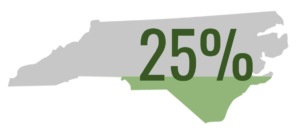
As you wrap up planting and begin to assess your soybean stands, here are a few ways to estimate your stands.
Row-length method. One common way is to count plants in a row. To determine stand using this method, count the number of plants in a row equal to 1/1000th of an acre. Reference the chart below or use the formula to determine the length of row to use.
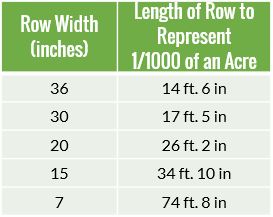
Make five to ten counts from different areas of the field, average these and multiply by 1,000 to get the plant population per acre.
Hula hoop method. Another common way is the hula hoop method. To determine stand using this method toss a hula hoop (or any perfectly round hoop, like a circle piece of wire or a barrel hoop) with a known diameter into a random location of the field and count the number of plants in the hoop. Do this five to ten times across different areas of the field and average these. Then multiply the average by the appropriate factor in the table below or use the formula to calculate the appropriate factor.
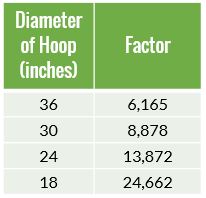
Remember: The radius of a circle is half the diameter.
Bean Cam App. For those of you who are tech savy, you may want to test out this Bean Cam App from the University of Wisconsin. The app can be downloaded here. The free, handy app calculates a field’s plant population by averaging five plant count samples at the VC, V1 or V2 growth stages. You simply snap five photos at random points in your field and the app will calculate your expected yield percent at harvest with and without spring replanting.
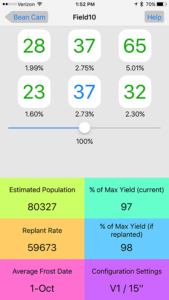
Regardless of the method used, be sure to count only live plants. Plants with stems broken off below the cotyledons should be considered dead. Some leaf damage can be tolerated, but plants with stem damage may or may not survive.
It’s really important to take time to get out in the field to get an accurate standout. It’s only natural to be drawn to the worst spots in the worst fields, but a more random approach is best. Otherwise, you may “over-estimate” emergence problems.
If your stands are lower than you were expecting – don’t panic. Soybeans have the unique ability to compensate for low stands and they produce similar yields across a range of plant populations. At this point in the year, even stands as low as 50,000 plants/acre should yield very close to the maximum (see this post, for more info on seeding rates).
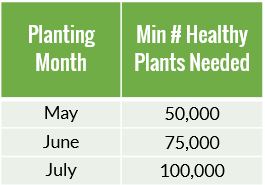
We don’t suggest replanting unless the stand is less than 50,000 plants/acre as the difference in yield will not cover the cost of replanting. And you may be better off investing the money you would have spent on replanting on an effective in-season residual to give you better control of weeds in areas with lower stands. If you do decide to replant, don’t tear up the stand and start over. Simply inter-plant new seed with a similar maturity into the existing stand.
Best of luck as you continue #plant18!







